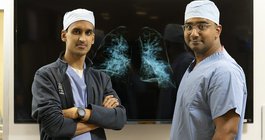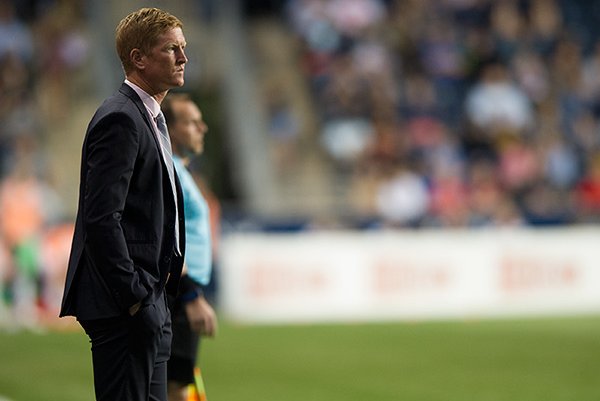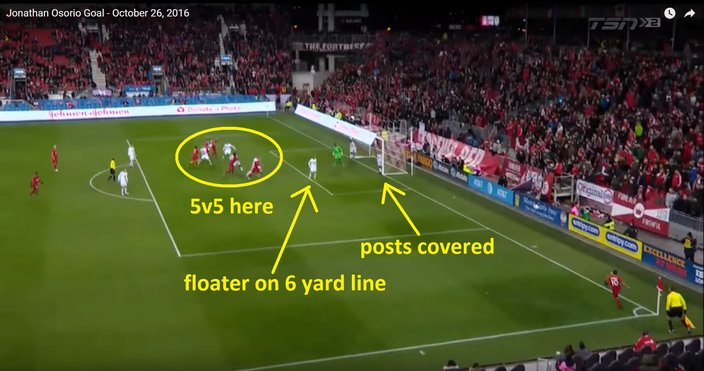
November 07, 2016
 Earl Gardner/Philly Soccer Page
Earl Gardner/Philly Soccer Page
Jim Curtin's Philadelphia Union finished with 11 wins, 14 losses, and nine draws in 2016.
A recent poll at "The Philly Soccer Page" finished with 54 percent of participants believing that Philadelphia Union head coach Jim Curtin should keep his job.
Thirty-four percent said that he should be fired and 12 percent responded with "I don't know."
Only 379 people voted.
That's a small sample size, and that's the problem with these kinds of questions. The Philadelphia Union fan base just isn't big enough to collect legitimate data determining how fans really feel about the most important topics. Even smaller is the number of supporters who would be considered "hardcore", meaning that they watch all of the games, pay attention to nuance, and devote more time and energy than the mostly indifferent suburban families that fill the bulk of the seats at Talen Energy Stadium.
Let's go through some of the key issues from this season, then you can decide for yourself how Curtin did in 2016.
The winter transfer window is muddled, and it's hard to know where to give credit because Sporting Director Earnie Stewart didn't officially join the club until January 1st of this year. How much of a role did he play in the acquisition of guys like Chris Pontius, Walter Restrepo, Anderson, or the first round draft picks? What role did Curtin, and technical director Chris Albright, have in the preseason roster building?
I think Curtin and Albright probably get the credit for adding Pontius, and for also targeting Keegan Rosenberry specifically in the draft. The Pontius deal was done early and Curtin knew Rosenberry from his time in the youth setup, so I can't imagine that Stewart took the lead on those additions.
I really don't know who went for Restrepo, Anderson, and Matt Jones. Ilsinho and Roland Alberg were definitely Stewart signings.
Additionally, C.J. Sapong was given a contract extension at $225,000 per year, for three years. Nobody seemed to have much of an issue with that in the preseason, but Sapong struggled down the stretch and arguably did not perform at a level consistent with that salary.
Ultimately, the transition at the top makes it hard to discern who is responsible for what, but the fact of the matter is that Philly went into the 2016 campaign with practically no depth in attack and the weakest strike force in the eastern conference.
The Union made some nice moves in the winter but still took an unbalanced roster into the season opener.
Let's try this - biggest issue with Curtin this season?
— Kevin Kinkead (@Kevin_Kinkead) November 7, 2016
Curtin had to deal with the mid-season departure of his best player, Vincent Nogueira. He also had to navigate the season-long absence of his captain and second-best player, Maurice Edu.
He's correct when he says that he never had a chance to get his best eleven players on the field.
That said, he had early success using Brian Carroll and Warren Creavalle, and constructing a side that was defensively impressive in the spring. That rigid shape and structure protected a young backline, which was further bolstered by the high-level of individual play from all-star goalkeeper Andre Blake.
Curtin's biggest personnel failure, in my opinion, was over-reliance on certain players. There was a point in the season where Ken Tribbett and Josh Yaro were both healthy, and Curtin stuck with Tribbett when Yaro was clearly the better option. Tribbett eventually played his way out of the lineup, and Yaro was recalled before becoming injured down the stretch. Tribbett played some very good games this season, and he was a great story entering 2016, but individual mistakes at the tail-end of the campaign really hurt the team.
Similarly, Curtin seemed to rate Fabian Herbers higher than the average Union fan. Herbers was a predictable sub early in the year and played as a lone striker off the bench. He was later used in a number ten role, then earned a starting spot at right midfield when Sebastien Le Toux was traded and Ilsinho was sidelined with a nagging plantar fasciitis issue.
Herbers improved down the stretch and learned the wide right position. He played his best soccer when the Union were slumping in the fall, and you wonder if his September and October contributions were wasted.
That said, the preference for Herbers in both spots kept Roland Alberg and Restrepo on the bench. Maybe Ilsinho could be included in that thought, but it's hard to know whether it was injury or preference that kept the Brazilian out of the starting eleven in October.
Alberg was clearly the better player at the number ten, even if he didn't play a lick of defense. Alberg was a pure goal scorer, relegated to the pine probably because he didn't work hard enough. Curtin's preference for dirty running, defensive wingers and a pugilist at the CAM spot resulted in his second highest goal scorer only playing 1,153 minutes this season.
I don't think that Curtin necessarily "plays favorites," but I think he has a tendency to show rigidness and predictability in this area.
And while we're at it - Curtin's best success this year?
— Kevin Kinkead (@Kevin_Kinkead) November 7, 2016
Curtin openly scoffed at the idea of shuffling the lineup on short turnaround situations, instead relying on an excellent sports science staff to prepare the same twelve or thirteen guys for busy stretches.
For the most part, it worked, which you saw with the 1-1 draw in Montreal, the 2-2 draw in Orlando, and the 1-1 draw in Colorado. Curtin was generally hesitant to change much of anything and didn't show much trust in his bench.
Ray Gaddis and Anderson started six games this year, while Rosenberry, Yaro, Tribbett, Fabinho, and Richie Marquez made 130 combined starts in defense. Rosenberry set a rookie record for minutes played and Marquez was third in the league.
As for substitutions, the biggest issue was probably with timing. Some subs simply came too late in the game, which you saw with those really short shifts for Alberg. Unless you're Alan Gordon, Semih Senturk, or Francesco Totti, you can't do much of anything in eight or ten minutes.
Charlie Davies barely got a sniff down the stretch and wasn't on the field to make much of an impact at all. C.J. Sapong was sometimes pulled out wide, with Herbers or Pontius going up top. The Union rarely came out of the 4-2-3-1, save for a couple of late-game situations where the team was playing from behind and trying to get another attacker on the field.
Did Curtin have many options on the bench?
Not really, but I think a few more halftime changes, or pre-60 minute subs would have made a difference here. There were very few times this year when you saw impactful changes from the Union bench.
@Kevin_Kinkead Great job getting a young team ready and confident. Terrible job at making adjustments along with the rest of the league.
— Stuart Seidel (@BowTieStu) November 7, 2016
I've talked at length about the Union's lack of tactical flexibility, which I think was the biggest issue down the stretch.
When Nogueira left the team, Curtin initially had success with the Carroll and Creavalle combo, then used Barnetta in the number eight spot for a time. That got Alberg onto the field, but the defense started to falter with the change in shape and an unrelated regression in overall play.
Alejandro Bedoya eventually filled that void, which allowed Barnetta to move back into his best spot. Bedoya was good for his first few games, then underwhelmed to finish the season as he adjusted to new settings and surroundings.
At the post-season press conference, Curtin and Stewart talked about the idea of going "back to basics" tactically when the going got tough in August and September. Instead of experimenting with a 4-4-2, or trying something different, they essentially wanted to double down on the 4-2-3-1 and try to reinforce the pressing and movement concepts that resulted in early season success. For whatever reason, they just struggled in that department at the end of the year.
The Union played 4-2-3-1 for 35 straight games this season, or actually something like 37 or 38 if you count the U.S. Open Cup games and the Crystal Palace friendly.
I understand the commitment to that set of tactics and the belief in continuity. I just feel like there was an opportunity to do a bit of experimenting in the summer after Nogueira took off.
One of the biggest frustrations was C.J. Sapong's scoring slump, which started in August and carried all the way to the end of the year. Every game featured a stranded Sapong, through no fault of his own, running around up top like a headless chicken trying to win the ball, hold the ball, and move his team forward. The isolation resulted in him finishing a bunch of games without a single shot on goal, or without a single shot at all. It seemed like nothing could be done to get Sapong going, and when that happens, you either have to adjust what you're doing or make a personnel change.
Neither happened.
@Kevin_Kinkead a bit resistant to change, needs personnel help (players and tacticians). He cares though and I'm good with that to start.
— David G (@ForzaUnion) November 7, 2016
Philadelphia's set piece defense was scandalous in 2016, but I disagree that coaching is to blame.
In design, the Union were generally solid in the way they approached corner kicks, with two men on the posts, a free floater on the six-yard line, and defenders matching up like-for-like. Most dead ball mistakes were the product of poor marking, ball watching, or just not being nasty or cynical enough in the box.
Restarts are about wanting it more, and you need to show some grit and savvy in the mixer. Marquez and Tribbett just weren't dirty enough in this area and allowed some veteran guys like Drew Moor and Kei Kamara to get the best of them through pulling, grabbing, clutching, or screening.
Could Curtin have done better in this department? Absolutely, but this is more about blooding young defenders through in-game experience.
 /for PhillyVoice
/for PhillyVoiceWe know that Curtin is an excellent communicator and public speaker in external settings, which sounds like an oxymoron.
I don't know what kind of relationship he has with his players, but he's very good with the media and the fans and he's an ambassador for soccer in a city that is mostly ambivalent towards the sport. Appearances on Breakfast on Broad or 97.5 the Fanatic might not matter to the average Union fan, but the truth is that we still have a long way to go in building the local soccer community. There will be people who hear those interviews and see those appearances, and maybe they come to a game or watch one on television.
Additionally, those spots with the "mainstream" Philadelphia media were incredibly vapid, with unprepared personalities asking generic Union questions before defaulting to lazy lines about Villanova (Curtin's alma mater) or the Philadelphia Eagles. Curtin gets bonus points just for dealing with people who couldn't be bothered to do five minutes of preparation for his appearances.
Anyway, I see a good amount of training, and I like the sessions. I think the players like the sessions. There's no standing around. Everything is high in repetition and intensity. We observe a lot of short-sided and full-sided exercises on Tuesdays and Wednesdays, while Thursdays and Fridays seem to have more of a game preparation and tactical slant to them. Admittedly, most of us don't make it down there for those practices, since we do most of our interviews and press conference duties earlier in the week.
We also don't know much about what goes on inside of the Power Training Complex. I know that film sessions are generally short, as players (and young people in general) tend to lose focus when they're staring at a screen in lieu of engagement. The players get along and the culture in Chester seems to have improved drastically.
I also think there's a good rapport between the front office and technical staff, and everything is streamlined for the first time in the existence of this franchise. Everyone seems to be on the same page, but I try not to give Earnie Stewart or Jim Curtin too much credit for that because you could have replaced Nick Sakiewicz with any number of people who would have improved that situation. There's a lot to be said for the head coach having the trust and support of the front office and the ownership group, and cohesiveness is a relatively new experience for Keystone Sports and Entertainment.
@Kevin_Kinkead A good players manager who is dedicated to the team, city, cause. Played the game, worked with academy kids, bright future.
— Jeff Manzella (@jeffmylene) November 7, 2016
Curtin had a limited squad to work with in 2016, and he used a tactical setup that maximized the strengths of the roster while masking its weaknesses.
The 4-2-3-1 made sense for a team that really only had one center forward option for the majority of the season. The midfield was the strength of the club, and so it made sense to get as many of them on the field as possible. This was a manager who had a young team punching above its weight for a good portion of the season. When you look at the talent around the Eastern Conference, you realize that this club had absolutely no business being near the top of the table.
This team didn't have a game-changer. There was no Piatti, no Altidore, no Villa, no Kljestan, and certainly no Giovinco.
That said, the predictability and lack of flexibility seem to be the two things that fans identify as the key frustrations with Curtin. We didn't see many changes in personnel or tactics at all.
One thing you should ask yourself is this: If not Jim Curtin, then who?
Would you go after an established American coach like Sigi Schmid? Does an experienced European manager take this team to the next level? Can Earnie Stewart lure a former Alkmaar or Breda manager to Philadelphia?
I get the sense that this club is committed to a young coach who is working with a young roster. There's certainly something to be said for constancy, and you don't want to be that joke of a club that fires the coach every other year.
But Union fans are frustrated, and at some point, you need to start winning. This was Stewart's first season at the helm, but it wasn't Curtin's. This was his second full year in charge, with a half-season of interim duty on top of that. This was also the Philadelphia Union's fifth losing season in seven years.
It feels like "Union 2.0", especially now that the training facilities and the infrastructure are finally up to par with the rest of the league. The proper executives are in the place. The technical staff is assembled. There's a young core and the academy is starting to produce first-team players.
The positives are there, and the future is bright, but next year a 13th-place finish and a positive spin on a bogus playoff appearance isn't going to fly.